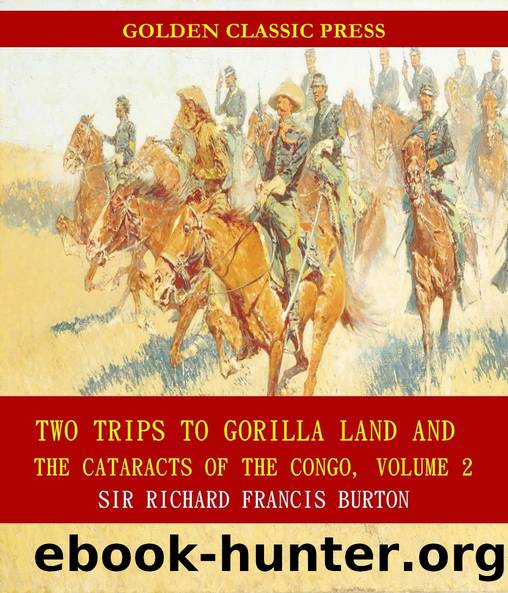Two Trips to Gorilla Land and the Cataracts of the Congo, Volume 2 by Burton Richard Francis Sir

Author:Burton, Richard Francis, Sir [Burton, Richard Francis, Sir]
Language: eng
Format: epub
Tags: Biography & Memoir, Literary, Historical, Nonfiction, History
ISBN: 1230002981536
Barnesnoble:
Publisher: GOLDEN CLASSIC PRESS
Published: 2018-12-07T05:00:00+00:00
A nous deux, Dr. E. Behm!
My objections to your paper are the three following: 1. It generally understates the volume of the Nzadi, by not allowing sufficiently for the double equinoctial periods of high water, March to June, as well as September to December; and by ignoring the north-equatorial supply. 2. It arbitrarily determines the question of the Tanganyika, separating it from the Nile-system upon the insufficient strength of a gorilla, and of an oil-palm which is specifically different from that of the Western Coast; and 3. It wilfully misrepresents Dr. Livingstone in the matter of the so-called Victoria Nyanza.
My first objection has been amply discussed. I therefore proceed to consider the second. As Mr. Alexander G. Findlay observed ("Proceedings of the Royal Geographical Society," No. 3, vol. xvii. of July 28, 1873):â"Up to the time of Stanley's arrival at Ujiji, and his journey to the north of the lake, Livingstone was fully impressed with the conviction that the Tanganyika is nothing more than what he called a lacustrine river' (329 miles long by twenty of average breadth); flowing steadily to the north and forming a portion of the Great Nile Basin. The letters contained his reasons for forming that opinion, stating that he had been for weeks and months on the shores of the lake watching the flow of the water northwards" (at the rate of a knot per hour). At times the current appeared to run southwards, but that was under the influence of strong northerly winds. Also by Dr. Livingstone's letters to Sir Thomas Maclear and Dr. Mann (" Proceedings of the Royal Geographical Society,"No. i of 1873, pp. 69-70), it is evident that the explorer believed only in the lake outlet north of Ujiji. Again, Mr. Findlay, after attentively considering the unsatisfactory visit of Dr. Livingstone and Mr. Stanley to the Rusizi River in November and December, 1871, holds it to be a mere marsh-drain, which when the south winds prevail, would possibly flow in the opposite direction; and he still believes that Captain Speke and I, when at Uvira, were within five or six miles of the head.
Since Dr. Livingstone's visit we have heard more upon this disputed subject. A native of Karagwah assured my friend Sir Samuel Bakerâwho, despite all prepossessions, candidly accepted the statementâthat it is possible and feasible to canoe from Chibero,on the so-called Albert Nyanza, past Uvira, where the stream narrows and where a pilot is required, to the Arab dépôt, Ujiji. He described the northern portion of the Tanganyika as varying much in breadth, immensely wide beyond Vacovia, and again contracting at Uvira. His report was confirmed by a MsawahÃli, sent by King Mtesa, with whom he had lived many years, to communicate with Baker Pasha at Fatiko; this man knew both Uvira and Ujiji, which he called "Uyiyi." Nothing can be more substantial than this double testimony, which wears all the semblance of truth.
On the other hand, Lieut. Cameron, whose admirable work has, so to speak, re-constructed the Tanganyika Lake, discovered, on the 3rd of May, 18-74, the Lukuga River, which he supposes to form the outlet.
Download
This site does not store any files on its server. We only index and link to content provided by other sites. Please contact the content providers to delete copyright contents if any and email us, we'll remove relevant links or contents immediately.
Marie Antoinette and the Downfall of Royalty by Imbert de Saint-Amand(358)
Astounding Stories, August, 1931 by Various Authors(274)
B-12's Moon Glow by Charles A. Stearns(266)
Historia Amoris by Edgar Saltus(260)
An Introduction to the Philosophy of Law by Unknown(251)
Arsene Lupin vs. Herlock Sholmes by Maurice Leblanc(245)
The Scottish Fairy Book by Elizabeth W. (Elizabeth Wilson) Grierson(233)
The Fade Tabletop by Jeremy Harris(215)
The Courtship of Morrice Buckler by A. E. W. Mason(210)
Memoirs of a Veteran: Personal Incidents, Experiences and Observations by Isaac Hermann(207)
Cottage Economy, to Which is Added The Poor Man's Friend by William Cobbett(202)
Euthenics, the science of controllable environment by Ellen H. (Ellen Henrietta) Richards(201)
A History of Witchcraft in England from 1558 to 1718 by Wallace Notestein(198)
Folk-Tales of the Khasis by Mrs. Rafy(194)
Humphrey, Duke of Gloucester: A Biography by Kenneth Hotham Vickers(187)
The Black Douglas by S. R. Crockett(187)
Love-Letters Between a Nobleman and His Sister by Aphra Behn(179)
Behind The Black Dome: An Advantage Player's Guide to Casino Surveillance by T. Dane(177)
Working Women of Japan by Sidney Lewis Gulick(174)
